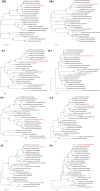Isolation and mutation trend analysis of influenza A virus subtype H9N2 in Egypt
- PMID: 22925485
- PMCID: PMC3492205
- DOI: 10.1186/1743-422X-9-173
Isolation and mutation trend analysis of influenza A virus subtype H9N2 in Egypt
Abstract
Background: Avian influenza virus H9N2 is a panzootic pathogen that affects poultry causing mild to moderate respiratory distress but has been associated with high morbidity and considerable mortality. Interspecies transmission of H9N2 from avian species to mammalian hosts does occur. The virus possesses human virus-like receptor specificity and it can infect humans producing flu-like illness.
Methods: Recently, mild influenza like symptoms were detected in H5N1 vaccinated flocks. Influenza A subtype H9N2 was isolated from the infected flock. The virus evolution was investigated by sequencing the viral genes to screen the possible virus recombination. The viral amino acid sequences from the isolated H9N2 strains were compared to other related sequences from the flu data base that were used to assess the robustness of the mutation trend. Changes in the species-associated amino acid residues or those that enabled virulence to mammals were allocated.
Results: Phylogenetic analyses of haemagglutinin and neuraminidase genes showed that the recently isolated Egyptian strain belonged to the H9N2 sub-lineage that prevails in Israel. The six internal segments of the isolated virus were found to be derived from the same sub-lineage with no new evidence of reassortment. The results demonstrated conserved genetic and biological constitution of H9N2 viruses in the Middle East. The recently isolated H9N2 virus from chicken in Egypt possessed amino acids that could enable the virus to replicate in mammals and caused severe disease in domestic chickens.
Conclusion: The study highlights the importance of continuous monitoring of the mutations evolved in avian influenza viruses and its impact on virulence to avian species in addition to its importance in the emergence of new strains with the capacity to be a pandemic candidate.
Figures

References
-
- Tong S, Li Y, Rivailler P, Conrardy C, Castillo DA, Chen LM, Recuenco S, Ellison JA, Davis CT, York IA, Turmelle AS, Moran D, Rogers S, Shi M, Tao Y, Weil MR, Tang K, Rowe LA, Sammons S, Xu X, Frace M, Lindblade KA, Cox NJ, Anderson LJ, Rupprecht CE, Donis RO. A distinct lineage of influenza A virus from bats. Proc Natl Acad Sci USA. 2012;109(11):4269–4274. - PMC - PubMed
-
- Guo YJ, Krauss S, Senne DA, Mo IP, Lo KS, Xiong XP, Norwood M, Shortridge KF, Webster RG, Guan Y. Characterization of the pathogenicity of members of the newly established H9N2 influenza virus lineages in Asia. Virology. 2000;267:279–288. - PubMed
-
- Brown IH, Banks J, Manvell RJ, Essen SC, Shell W, Slomka M, Londt B, Alexander DJ. Recent epidemiology and ecology of influenza A viruses in avian species in Europe and the Middle East. Dev Biol (Basel) 2006;124:45–50. - PubMed
MeSH terms
Substances
Associated data
- Actions
- Actions
- Actions
- Actions
- Actions
- Actions
- Actions
- Actions
LinkOut - more resources
Full Text Sources
Medical

